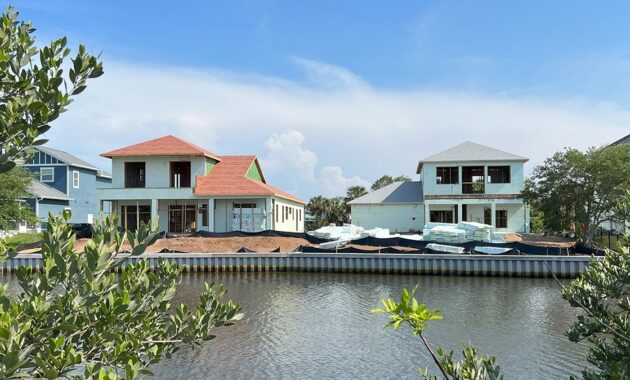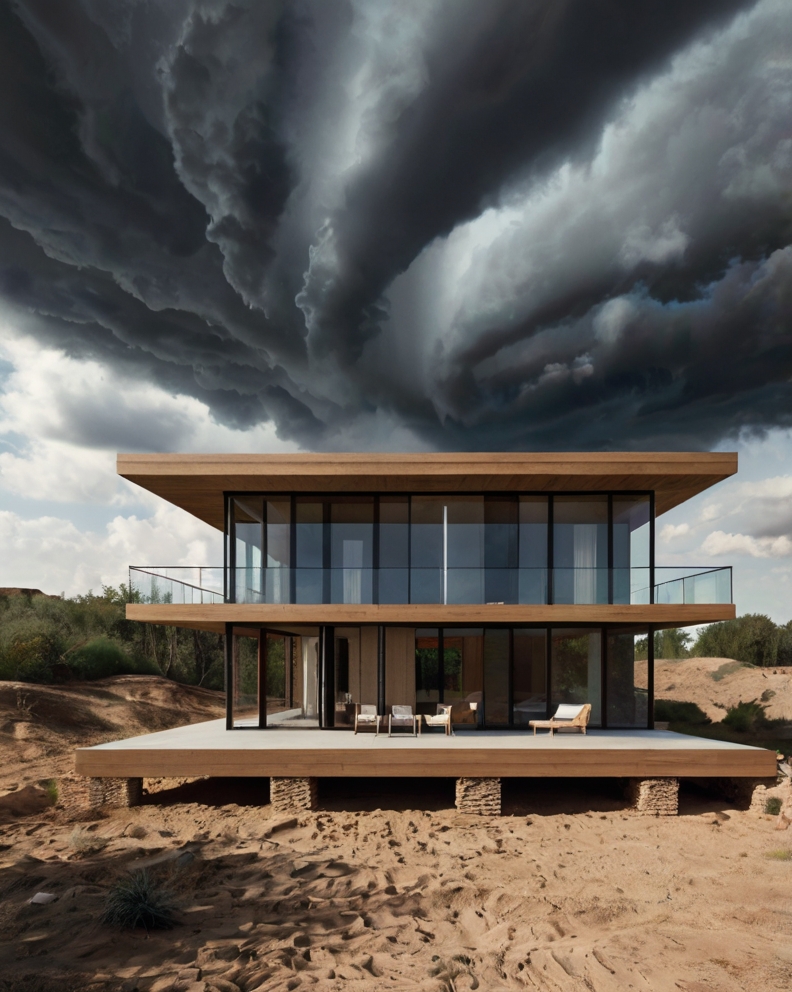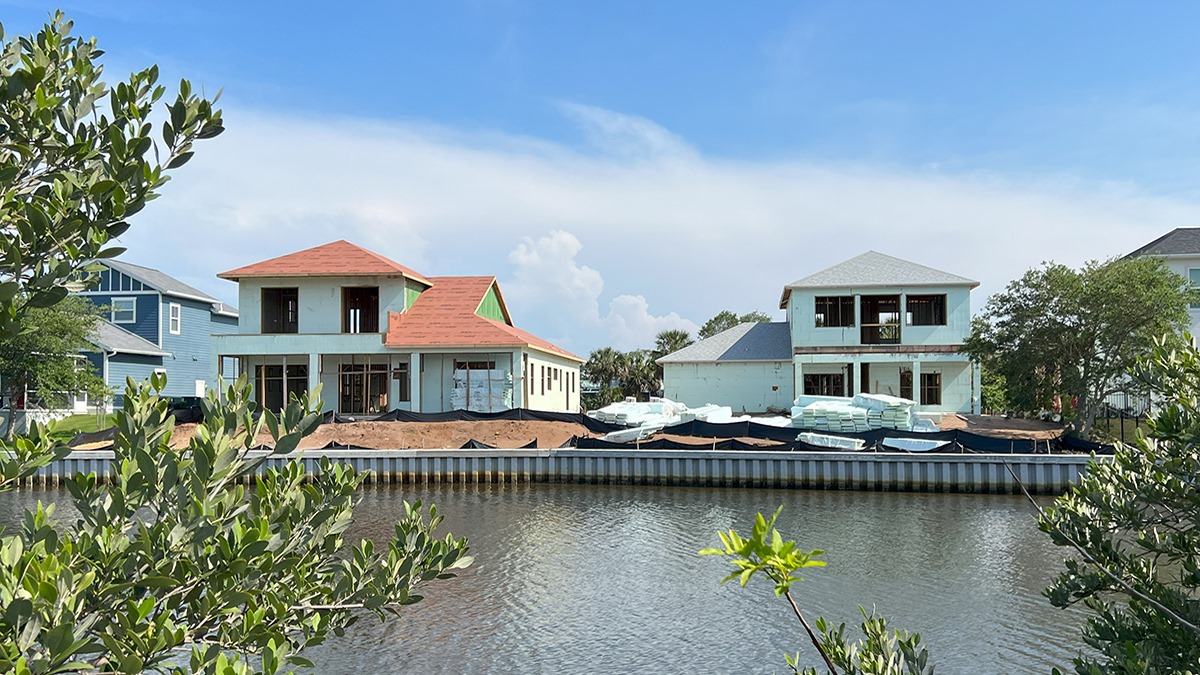Storm Resistant Homes – As extreme weather events like hurricanes, tornadoes, and severe storms become more frequent due to climate change, building homes that can withstand these natural forces is more crucial than ever.
Designing and constructing storm-resistant homes is not just a matter of preference—it can be a lifesaver.
In this comprehensive guide, we’ll explore key features and considerations when designing a home that can resist storm damage, ensuring safety and minimizing costly repairs.

1. Foundation: The Bedrock of Safety
A strong foundation is essential in preventing a home from shifting or collapsing during high winds, flooding, or storm surges.
For storm-resistant homes, deeply anchored foundations provide superior stability. Some of the most effective foundation techniques include:
- Piling foundations: Especially in flood-prone areas or coastal regions, piling systems elevate the home and anchor it deep into the ground. This minimizes the risk of flooding and helps the house withstand the forces of storm surges or winds.
- Slab-on-grade foundation: Suitable for areas where flooding is less of a concern but high winds are a threat. This method creates a large, heavy base, giving the home more resistance against uplift forces caused by wind – Storm Resistant Homes.
A solid foundation also integrates well with storm-resilient building materials to form a unified structure.
Foundation: The Bedrock of Safety for Storm-Resistant Homes – Government Recommendations
Building storm-resistant homes starts with a solid foundation, which acts as the bedrock of safety against natural disasters like hurricanes, tornadoes, floods, and storm surges.
Governments, especially in disaster-prone regions, have developed guidelines and recommendations for constructing foundations that can withstand extreme weather conditions.
These recommendations help ensure that homes are built to minimize damage and maximize occupant safety. Below are key government-backed recommendations for storm-resistant foundations:
a. Choose the Right Foundation Type for the Region
Different areas experience different natural hazards, and the foundation type must be suited to the specific risks of the region. Government agencies, such as the Federal Emergency Management Agency (FEMA) in the United States, provide specific recommendations for various regions.
- Coastal Areas (Flood and Storm Surge Zones): In areas prone to flooding and storm surges, FEMA recommends using elevated foundations, such as pile or pier-and-beam foundations. These designs raise the structure above the potential flood level, reducing the risk of water damage. Foundations should be built to allow water to flow through without causing structural damage.
- Hurricane and High Wind Areas: For regions vulnerable to hurricanes and strong winds, a reinforced concrete slab or deep footing foundation is recommended. The foundation must be anchored securely to resist lateral movement caused by wind forces, ensuring that the house remains stable and secure during high-wind events.
b. Elevate Foundations in Flood-Prone Areas
One of the most important government guidelines for storm-resistant homes, particularly in flood-prone areas, is the requirement to elevate the foundation above the Base Flood Elevation (BFE). The BFE is the estimated height floodwaters are expected to rise during a 100-year flood event.
- FEMA Guidelines: FEMA recommends that homes in flood zones be elevated on stilts, piers, or piles to protect against rising water. The foundation should be high enough to account for sea-level rise and future storm surge projections. Additionally, crawlspaces should be designed with flood vents to allow water to flow freely through the foundation without causing damage.
c. Use Reinforced Concrete and Steel for Added Strength
Government recommendations for storm-resistant homes often emphasize the use of reinforced concrete and steel in foundation construction. Reinforcing the foundation with steel bars (rebar) ensures that it can resist the stress from both uplift forces during hurricanes and the lateral forces during earthquakes.
- Building Codes for Reinforcement: Local building codes, informed by FEMA and the American Society of Civil Engineers (ASCE), often specify the minimum standards for reinforcing materials in foundation construction. This includes guidelines on the thickness of the concrete slab, the number of steel reinforcements, and the depth of the footings to ensure stability.
d. Install Storm-Safe Anchors and Tie-Downs
To keep the home securely fastened to its foundation during a storm, government guidelines recommend installing storm-safe anchors or tie-downs. These structural elements help prevent homes from being uplifted by high winds or storm surges.
- Anchor Bolts and Straps: FEMA recommends the use of heavy-duty anchor bolts and metal straps that connect the home’s frame directly to the foundation. These connections resist uplift forces that can cause the house to be torn from its base, a common occurrence during tornadoes and hurricanes.
e. Erosion Control for Coastal and Riverine Areas
In coastal regions and areas near rivers, erosion caused by storm surges and flooding can undermine the foundation. Government guidelines emphasize the importance of erosion control measures to protect the foundation from soil displacement.
- Deep Foundations: The National Oceanic and Atmospheric Administration (NOAA) recommends deep pile foundations for homes near the coastline. Piles should be driven into bedrock or stable soil layers below the erosion line to prevent the house from shifting or collapsing if the surface soil is washed away.
f. Waterproofing and Drainage Solutions
For storm-resistant foundations, especially in flood-prone areas, government agencies stress the importance of waterproofing and effective drainage systems. Preventing water from penetrating the foundation is crucial to maintaining the structural integrity of the home.
- Foundation Sealing: FEMA and the U.S. Department of Housing and Urban Development (HUD) recommend applying waterproof membranes or sealants to foundations, particularly for slab or basement foundations. This prevents water from seeping into the structure during floods, which can weaken the foundation over time.
- Proper Drainage Systems: Homes should be equipped with drainage systems like French drains, sump pumps, and proper grading around the foundation to direct water away from the house. This prevents water from pooling near the foundation and causing damage.
g. Follow Local Building Codes and Standards
Local governments often adopt building codes based on national standards that are specific to the risks faced by each region. These codes, informed by FEMA, HUD, and other federal agencies, are designed to ensure that homes are built to withstand local hazards such as hurricanes, floods, and earthquakes.
- Compliance with International Building Code (IBC): The IBC outlines detailed requirements for foundation design and construction to resist wind loads, flood forces, and seismic activity. Ensuring that the home’s foundation meets or exceeds these standards is essential for storm resilience.
- Permits and Inspections: Government recommendations emphasize the importance of securing proper permits and undergoing inspections during construction. These inspections ensure that foundations are built according to code and are safe for occupancy.
h. Retrofitting for Existing Homes
For homes built before modern building codes were in place, the government recommends retrofitting the foundation to meet current storm-resistant standards. Retrofitting can involve reinforcing the existing foundation, adding storm anchors, or raising the structure above flood levels.
- FEMA’s Retrofitting Guidelines: FEMA provides detailed guidance on how to retrofit homes to improve storm resistance, including elevating homes, strengthening foundations with concrete and steel reinforcements, and installing flood barriers.
Read also:
a. Building a Tornado-Resistant Home: Key Strategies for Safety and Durability
b. Building Landslide-Resistant Homes: Key Strategies for Stability and Safety
c. Designing Flood-Safe Houses and Necessary Preparations




2. Shape of the Building: Aerodynamics Against Wind
The shape of the home can significantly impact how well it stands up to high winds. Structures with complex shapes like gabled roofs or multiple corners can create wind pressure points that are vulnerable during storms. To combat this:
- Opt for simple geometric shapes like squares or rectangles, which distribute wind loads more evenly.
- Round or hexagonal homes are excellent choices in hurricane-prone areas. These shapes allow winds to move around the structure more smoothly, reducing the impact on the walls and roof.
- Low-pitched roofs are less likely to be lifted by strong winds, and combining them with features like overhangs and aerodynamic designs can further reduce wind stress.
Read also: Building a Hurricane-Resistant Home: Key Features and Considerations
3. Storm-Resistant Materials: Building a Tough Exterior
Choosing the right materials is fundamental to constructing a storm-proof home. The focus should be on materials that can endure high winds, impact from debris, and water damage – Storm Resistant Homes.
- Concrete: Reinforced concrete, especially precast panels or concrete blocks, is one of the best materials for resisting storm damage. It’s incredibly durable, resistant to water damage, and can withstand high-impact forces.
- Steel: When used in roofing or structural framing, steel provides excellent wind resistance. Steel frames are strong and flexible, allowing the structure to bend under stress rather than break.
- Impact-resistant glass: For windows, opting for laminated or tempered glass that is designed to withstand flying debris is critical. Impact-resistant glass, often used in hurricane-prone regions, can prevent windows from shattering.
- Fiberglass: For roofing and siding, fiberglass is lightweight yet incredibly tough. It can withstand wind, impact, and water, making it a top choice for storm-resistant homes.
4. Roof Design: Securing the Top Layer
Roofs are often the first part of a house to sustain damage during a storm. Designing a roof that is resistant to high winds and rain requires careful consideration:
- Hip roofs: These are superior to gable roofs in storm resistance. A hip roof slopes down on all sides, reducing wind uplift, and is better suited for extreme weather conditions.
- Roof bracing and anchoring: Reinforcing the roof structure with extra bracing and properly anchoring it to the walls and foundation will help it stay intact during storms.
- Seamless metal roofing: Metal roofs, particularly those made from steel or aluminum, are durable and offer great wind resistance. Seamless metal sheets also reduce the risk of leakage during heavy rain.
Read also: Eco-Friendly Building Materials That Are Changing Home Construction
5. Storm Shutters and Protective Barriers
To protect windows and doors from flying debris and high winds, storm shutters are a necessary addition:
- Accordion and roll-down shutters: These provide robust protection and are easily deployed before a storm. They can be made from aluminum or other impact-resistant materials.
- Plywood: While plywood panels are a more affordable option, they should be properly sized and installed well in advance of a storm for maximum effectiveness.
In addition to shutters, reinforced doors and garage doors should also be installed – Storm Resistant Homes. Doors should be constructed from heavy-duty materials like steel, and garage doors should have additional bracing or be wind-rated.
6. Flood Mitigation: Preventing Water Damage
Flooding can cause catastrophic damage to a home. Incorporating flood mitigation strategies will help preserve the integrity of the structure:
- Elevated building: Elevating homes on stilts or pilings in flood-prone areas is one of the most effective ways to prevent water from entering the home.
- Flood vents: These allow water to flow through and out of the building rather than accumulating pressure against the walls. It’s important to install these vents at strategic points along the foundation – Storm Resistant Homes.
- Waterproof materials: Using water-resistant materials for walls, floors, and even furniture can minimize damage in the event of flooding. For example, using concrete, ceramic tiles, and non-porous insulation reduces the risk of mold and long-term structural damage.
7. Safe Rooms: The Ultimate Shelter
In regions where tornadoes or hurricanes pose significant threats, including a safe room in the house design is an essential consideration. A safe room is a fortified space designed to withstand extreme winds and flying debris:
- Interior placement: The safe room should be centrally located in the house, ideally on the ground floor, and surrounded by interior walls for added protection.
- Reinforced concrete or steel: The walls, ceiling, and door of the safe room should be made from reinforced concrete or steel to ensure maximum protection.
- Ventilation and supplies: Ensure the room is equipped with proper ventilation, emergency supplies, and enough space to shelter the home’s occupants during a storm – Storm Resistant Homes.
8. Backup Power and Utility Protection
Power outages during storms are common, and having backup power sources is essential. Install:
- Generators or solar power systems to keep essential systems running, such as refrigeration, lighting, and communications.
- Surge protection: Protect electrical systems from lightning strikes or power surges with whole-house surge protectors.
Additionally, utilities like HVAC systems, water heaters, and electrical panels should be elevated above flood levels to prevent damage during a storm.
9. Landscaping: Deflecting the Elements – Storm Resistant Homes
Finally, the surroundings of the home can also play a significant role in storm resistance. Thoughtful landscaping can minimize damage:
- Windbreaks: Planting trees and shrubs that are native to the region can act as natural barriers to high winds. They help slow down gusts before they reach the home.
- Permeable surfaces: Using permeable paving materials in driveways and walkways can reduce flooding by allowing water to absorb into the ground rather than pooling.
- Grading and drainage: Properly grading the land around the home to slope away from the foundation can prevent water from accumulating near the house, reducing the risk of flooding.
Conclusion: Future-Proofing Your Home Against Storms
Building a storm-resistant home requires a combination of thoughtful design, durable materials, and protective measures. Storm Resistant Homes – By addressing each aspect of construction—from the foundation and roof to the choice of windows and landscaping—you can create a structure that not only resists storm damage but also provides peace of mind.
As climate change continues to influence weather patterns, investing in storm-proofing is more than just a precaution—it’s a necessity for the future.
Storm-Resistant Homes: Alabama, Alaska, Arizona, Arkansas, California, Colorado, Connecticut, Delaware, Florida, Georgia, Hawaii, Idaho, Illinois, Indiana, Iowa, Kansas, Kentucky, Louisiana, Maine, Maryland, Massachusetts, Michigan, Minnesota, Mississippi, Missouri, Montana, Nebraska, Nevada, New Hampshire, New Jersey, New Mexico, New York, North Carolina, North Dakota, Ohio, Oklahoma, Oregon, Pennsylvania, Rhode Island, South Carolina, South Dakota, Tennessee, Texas, Utah, Vermont, Virginia, Washington, West Virginia, Wisconsin, Wyoming.
Buenos Aires, Argentina; São Paulo, Brazil; Rio de Janeiro, Brazil; Bogotá, Colombia; Lima, Peru; Santiago, Chile; Caracas, Venezuela; Montevideo, Uruguay; Quito, Ecuador; Asunción, Paraguay; La Paz, Bolivia; Sucre, Bolivia; Medellín, Colombia; Cali, Colombia; Guayaquil, Ecuador; Valparaíso, Chile; Rosario, Argentina; Córdoba, Argentina; Maracaibo, Venezuela; Barranquilla, Colombia; Manaus, Brazil.
Africa:
Cairo, Lagos, Nairobi, Dakar, Johannesburg, Casablanca, Addis Ababa, Accra, Tunis, Lusaka, Harare, Kampala, Algiers, Khartoum, Mogadishu, Freetown, Windhoek, Kigali, Bamako, Dar es Salaam.
Australia:
Sydney, Melbourne, Brisbane, Perth, Adelaide, Hobart, Darwin, Canberra, Gold Coast, Cairns, Newcastle, Wollongong, Geelong, Townsville, Launceston, Toowoomba, Ballarat, Bendigo, Albury, Rockhampton.
Europe:
London, Paris, Rome, Berlin, Madrid, Vienna, Amsterdam, Lisbon, Prague, Athens, Brussels, Copenhagen, Oslo, Dublin, Warsaw, Helsinki, Stockholm, Budapest, Edinburgh, Zurich, Munich.







